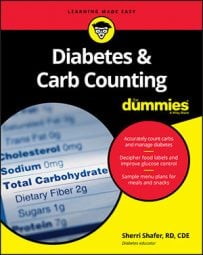- Hard alcohol (distilled spirits) doesn't have any carbs, except for whatever it's mixed with.
- Most wines have only 3–5 grams of carbohydrate per 5-ounce glass. The sugar from the grape juice turned into alcohol during the fermentation process.
- Beer has roughly 13 grams of carb per 12-ounce portion. The carbs in beer come from wheat, barley, or malt.
Insulin users may wonder whether they should "cover the carbs" in their alcoholic beverages with insulin. That may work okay at mealtime for one drink: for example, if you have a beer with a carb-containing dinner. Say the beer has 13 grams of carb and the meal has 55 grams of carb. You may be fine counting the total as 68 grams of carb and taking the appropriate dose of insulin. The food and the insulin both last about four hours. The alcohol should be done processing within about two hours. That's why you're less likely to get low blood sugar if you have your drink with a meal.
However, drinking on an empty stomach is a different story. Consider this: If you take insulin to cover the carbs in an alcoholic beverage, the rapid-acting insulin will last about four hours, but the liquid carbs in a beer or in carb-containing mixers will be digested very quickly — within 15 minutes of drinking. On an empty stomach, alcohol has a blood-glucose-lowering effect for two or more hours per drink. The carbs won't last as long as the alcohol and the insulin, which increases the risk of having hypoglycemia.
Talk to your doctor about insulin and alcohol. The discussion in this book is conceptual and not meant to provide insulin dosing instructions. Medication use and adjustments must be discussed with your doctor.
Some alcoholic beverages have carbs, but all of them have calories. Alcohol has 7 calories per gram, protein and carbohydrate have 4 calories per gram each, and fat has 9 calories per gram, so fat and alcohol are the most calorically dense. Alcohol can contribute to weight gain, so it's important to account for the calories consumed. The table lists popular alcoholic beverages and their average carb and calorie counts. Extra stout beers would have more carbs and calories than listed, and beers in general vary by brand. Mixed drinks have a wide range of carb and calorie counts — too wide to mention here — but some frou-frou drinks push upwards of 500 calories up that straw.The Carb and Calorie Counts of Common Alcoholic Beverages
| Beverage | Grams of Carb | Calorie Count |
| 80 proof spirits — 1.5 oz. | 0 | 100 |
| Wine (red or white) — 5 oz. | 3–5 | 125 |
| Beer (light) — 12 oz. | 5–6 | 100 |
| Beers (average) — 12 oz. | 11–15 | 150 |
The numbers listed in the table represent some averages across the categories mentioned, but there is certainly variation. Check labels, look online, or contact manufacturers for details.

